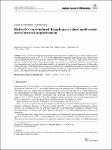Search
Author
- Carlos, Alegría (2)
- Carlos, Seara (2)
- David, Orden (2)
- Klaus, Bretterbauer (2)
- next >
Subject
Date issued
Has File(s)
- true (287)
Search Results
We consider trees with root at infinity endowed with flow measures, which are nondoubling measures of at least exponential growth and which do not satisfy the isoperimetric inequality. In this setting, we develop a Calderón–Zygmund theory and we define BMO and Hardy spaces, proving a number of desired results extending the corresponding theory as known in more classical settings. |
In this paper, we propose a treatment of some class of differential–difference operators in dimension one from the spectral theory point of view. These operators emerge as symmetrizations of differential operators on (0, b), 0 |
We construct and analyze a domain decomposition method to solve a class of singularly perturbed parabolic problems of reaction-diffusion type having Robin boundary conditions. The method considers three subdomains, of which two are finely meshed, and the other is coarsely meshed. The partial differential equation associated with the problem is discretized using the finite difference scheme on each subdomain, while the Robin boundary conditions associated with the problem are approximated using a special finite difference scheme to maintain the accuracy. |
Here, we present multivariate quantitative approximations of Banach space valued continuous multivariate functions on a box or RN, N∈N, by the multivariate normalized, quasi-interpolation, Kantorovich-type and quadrature-type neural network operators. We examine also the case of approximation by iterated operators of the last four types. These approximations are achieved by establishing multidimensional Jackson type inequalities involving the multivariate modulus of continuity of the engaged function or its high-order Fréchet derivatives. Our multivariate operators are defined using a multidimensional density function induced by the Richards’s curve, which is a generalized logistic function. |
We investigate the application of ensemble transform approaches to Bayesian inference of logistic regression problems. Our approach relies on appropriate extensions of the popular ensemble Kalman filter and the feedback particle filter to the cross entropy loss function and is based on a well-established homotopy approach to Bayesian inference. The arising finite particle evolution equations as well as their mean-field limits are affine-invariant. Furthermore, the proposed methods can be implemented in a gradient-free manner in case of nonlinear logistic regression and the data can be randomly subsampled similar to mini-batching of stochastic gradient descent. |
Theta sums are finite exponential sums with a quadratic form in the oscillatory phase. This paper establishes new upper bounds for theta sums in the case of smooth and box truncations. This generalises a classic 1977 result of Fiedler, Jurkat and Körner for one-variable theta sums and, in the multi-variable case, improves previous estimates obtained by Cosentino and Flaminio in 2015. Key steps in our approach are the automorphic representation of theta functions and their growth in the cusps of the underlying homogeneous space. |
In this article, we show the existence of closed embedded self-shrinkers in Rn+1 that are topologically of type S1×M, where M⊂Sn is any isoparametric hypersurface in Sn for which the multiplicities of the principle curvatures agree. This yields new examples of closed self-shrinkers, for example self-shrinkers of topological type S1×Sk×Sk⊂R2k+2 for any k. If the number of distinct principle curvatures of M is one, the resulting self-shrinker is topologically S1×Sn−1 and the construction recovers Angenent’s shrinking doughnut (Angenent in Shrinking doughnuts, Birkhäuser, Boston, pp 21–38). |
These are natural generalizations of the classical Hilbert and Cesàro operators. A good amount of work has been devoted recently to study the action of these operators on distinct spaces of analytic functions in D
. In this paper we study the action of the operators Hμ and Cμ on the Dirichlet space D and, more generally, on the analytic Besov spaces Bp (1≤p<∞). |
We consider the Post–Widder operators of semi-exponential type, which are a generalization of the exponential operators connected with x2. This modification has the beauty to find difference with other operators, while the original Post–Widder operators do not have such property. We estimate quantitative difference of these operators with Baskakov type operators and Szász–Kantorovich operators, along with some composition of operators. Finally, we further consider a form preserving linear functions and estimate some direct results. |
As explained therein by Venkatesh, in many interesting number theory problems (e.g., counting number fields, arithmetic curves or abelian varieties over a number field) one has not only a main term in the asymptotic count, but a secondary term or more. We have very little understanding of these lower order terms. They are not just of theoretical interest: when one tries to verify the conjectures numerically, one finds that the secondary terms are dominant in the computational range. For example, the number of cubic number fields of height ≤B
for certain constants a,b>0 is aB+bB5/6+o(B56). |










